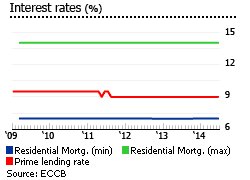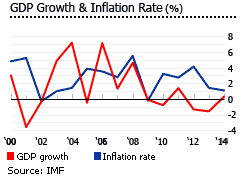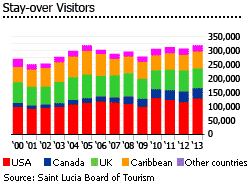St. Lucia's property market remains stable
St Lucia is often called “The Helen of the West Indies” for its captivating beauty. With a total land area of about 620 square miles, St Lucia is one of the most beautiful islands in the world.
Yet residential property prices have risen only minimally in Saint Lucia over the past several years, mainly due to the global financial crisis. Despite this, there have been numerous residential developments over the past decade, a notable feature being attractive tax incentives. St. Lucia has a somewhat odd economy, highly dependent on tourism, and with 23% unemployment. Yet there is an increasing 'buzz' about St. Lucia
The island has excellent beaches, scenic waterfalls, mountains, rainforests, orchids and exotic plants. The twin mountain peaks of Les Piton drop dramatically to the water´s edge on the west coast. In the south, visitors get close to bubbling pools of lava and steaming sulfurous spouts at Sulphur Springs Volcano, or splash in the sulfur-infused waters of the Diamond Waterfall and Mineral Baths.
The higher-end residential market is the strongest. Larger apartment prices have risen from US$2.15 million maximum in 2011, to US$3 million currently.
In The Landings, in Rodney Bay on St Lucia’s northwest, one-bedroom apartment prices now start at US$550,000, unchanged over the past three years. The Landings was St. Lucia’s first residential private yacht harbour. It opened in December 2007. About 70% of buyers are British.
In the Allamanda, villas now sell at US$1.9 million, almost unchanged from US$1.85 million in 2011. The Allamanda is in Anse Galet, on St Lucia's northernmost tip./
other residential developments like The Seaside, Marquis Estate, Cotton Bay Resort and The Tides Sugar Beach, apartments and villa prices were almost unchanged in the past three years, based on current advertisements.
Despite sluggish house price rises, St. Lucia continues to attract foreign investors and visitors. In fact, the island is increasingly seen as one of the world’s most interesting property markets. St. Lucia is in many ways comparable to neighboring Barbados, but its prices are about 40% to 60% lower.
A note of caution. St. Lucia offers great tax breaks, and is stunningly beautiful. But yields on condos are some of the lowest in the world, at 2.3% gross. So if you are looking for income from your property, you need to be selective. Houses in St. Lucia, on the other hand, can earn reasonable rental returns, at 3.57% gross, according to a Global Property Guide research.
Reasons for the rising buzz about St Lucia:
- The island is one of the most accessible in the region, with direct flights from the US, Canada, Germany, and the UK. British Airways recently increased direct flights from Gatwick to St. Lucia.
- One of the region’s lowest crime rates.
- A tax haven with no VAT, no capital gains tax, no inheritance tax and no estate tax.
- Top destination for weddings and honeymoons
- St. Lucia boasts a world-class casino, plus a multi-million pound shopping mall with a multi-screen cinema, and new restaurants and bars.
- St. Lucia celebrates a few unique events every year such as the Caribbean20 Cricket Tournament (January), Nobel Laureate Week (January), St. Lucia Jazz & Arts Festival (May), St. Lucia Carnival (July), Creole Day (October), Oktoberfest En Kwéyòl (October), and the Atlantic Rally for Cruisers (December).
- St. Lucia has a new niche—health and wellness. With the support of the government and other private institutions, St Lucia’s Health and Wellness Retreat, an annual event where guests can enjoy an array of health and wellness activities, workshops, and other treatments, was launched in November 2011.
St. Lucia’s currency is pegged to the US dollar at EC$2.7 to US$1.
Local house price variations
Most new developments are in the island’s north, including Castries, the capital city, and Rodney Bay. South Coast development is limited by strict planning laws, and by the area’s dense rainforest.
There are vast differences between prices in different developments, as would be expected. At the cheap end is the Cap Estate Development (situated in the north of St. Lucia), where a one-bedroom Bougainvillea Condo in Gate Park now sells for US$150,000.
On the other hand, a luxurious condominium unit at The Landings Residences and Marina Resort sells for US$1,750,000.
In Emerald Vista Luxury Residences, a three-bedroom residential property was listed at a price of US$500,000. In Palmiste Cove, one can purchase a two-bedroom house at US$160,000. And so it goes on.
In the Aron Vale Residences, a 13 acre residential development situated in Beausejour, Gros Islet, properties are priced as follows:
ARON VALE RESIDENCES |
|||
| HOME TYPE | AVERAGE LOT SIZE (SQ. FT.) | PRICE (EC$) | PRICE (US$) |
| Detached Home A | 9,000 | 735,000 | 272,222 |
| Detached Home B | 9,500 | 850,000 | 314,815 |
| Detached Home C | 10,000 | 900,000 | 333,333 |
| Detached Home D | 10,000 | 985,000 | 364,815 |
| Townhouse | 5,000 | 875,000 | 324,074 |
| Duplex | 4,500 | 635,000 | 235,185 |
Land prices have been stable
Land prices in St. Lucia have been moving in step with house and condo prices, rising modestly over the past three years, according to local property experts.
In the first phase of developments of the Sea Breeze Hills, located on the northern tip of the island, a residential lot between ½ acre and 1 acre is currently priced starting from US$200,000 up to US$450,000.
In the Sea Breeze Heights, also situated in the northern part of St. Lucia which offers luxury home sites, a same sized residential lot is offered at a price ranging from US$300,000 to US$1,000,000.
The mortgage market has recently grown rapidly. Mortgages are available to foreigners, but at a price.

Property in St. Lucia is usually bought for cash, in foreign currency (US dollars). However there has been a noticeable rise in mortgage loans during the latest two years tracked by the Eastern Caribbean Central Bank (ECCB), with the mortgage market growing to 25.7% of GDP in 2013. Before that the mortgage market hardly grew over a decade, rising from 18% of GDP in 1997 to only 18.6% of GDP in 2011, according the ECCB.
St. Lucia’s banks offer mortgages to non-residents. Interest rates are about 3% above US LIBOR, with maximum loan to value (LTV) ratios from 60% and 70%, and terms up to 25 years. Non-residents can borrow up to US$1.5 million.

In June 2014, the total amount of loans for the acquisition of property in St. Lucia rose by 7.1% from a year earlier, to EC$967.45 million (US$358.31 million), according to the ECCB. Of the total amount, about 38% was for house and land purchases, while 68% was for home construction and renovation. The acquisition of property as percent of total loans was 22% in June 2014, the highest level since June 2005.
In June 2014, the prime lending rate in St. Lucia stood at 9%, unchanged since August 2011. Interest rates for residential mortgages ranged from 7% to 14%, based on ECCB figures.
Most landlords prefer to rent to short-term vacationers
The supply of long-term private rental properties in St Lucia is limited, as most landlords prefer to rent to short-term vacationers. Rental properties are concentrated on the northwestern coast, especially in Castries.
In the Cap Estate Development, the monthly rent for a one-bedroom Bougainvillea Condo in Gate Park was US$1,000.
Residential property prices fell in 2009 and 2010 and remained steady in the years thereafter, which indicated that gross rental yields have fallen. The gross rental yields for houses stood at 3.57% in 2012, down from 4.5%-6% in 2011 and 3.3%-4.3% in 2010, according to a Global Property Guide research.
There is no tax on rental income for the first 10 years of property ownership.
Meagre economic growth, rising unemployment

St Lucia's economy is largely tourism-dependent. It has been weak in the past several years, due to the adverse impact of the global financial crisis and aggravated by the eurozone debt crisis. It is expected to expand by a meagre 0.34% this year, according to the International Monetary Fund (IMF). In 2013, the economy contracted by 1.5%, after a decline of 1.3% in 2012, a minimal growth of 1.4% in 2011, and declines of 0.7% in 2010 and another 0.1% in 2009.
Inflation stood at 3.37% in the first quarter of 2014, according to the Central Statistical Office. Inflation was 1.5% in 2013, down from 4.2% in 2012, 2.8% in 2011 and 3.3% in 2010, according to the IMF.
St. Lucia’s unemployment increased to 23.3% in 2013 from 21.4% in 2012, according to the CSO.
Twin pillars of St. Lucia’s economy: construction & tourism
Economic growth in St. Lucia is driven by tourism and construction. However, both tourism and the construction sector weakened during the global crisis, resulting in economic decline.
Fortunately, tourism and construction have gradually recovered. In 2013, there were about 960,617 visitor arrivals, up by 3.2% on the previous year, based on figures from St. Lucia Tourist Board. Out of the total number of visitors last year, 62% were cruise ship passengers while 33% were stay-over visitors. Most of the stay-over visitors came from the United States, Canada, the UK, and other Caribbean countries.
Visitor expenditures in St. Lucia increased by 5% to EC$955.42 million (US$353.86 million) in 2013, based on ECCB estimates.
French patois culture

French influence is deeply felt in St. Lucia today, in the names of its cities, towns and bays, in the architecture and in the French-inflected patois spoken by the islanders. However, English is spoken at all major hotels, major tourist attractions and restaurants. The UK and France spent almost two centuries fighting to control the island.
St Lucia’s world-class annual events add to its appeal to tourists and holiday makers. Popular events include the Atlantic Rally for Cruisers (ARC), the Rose Festival and the Jazz Festival.